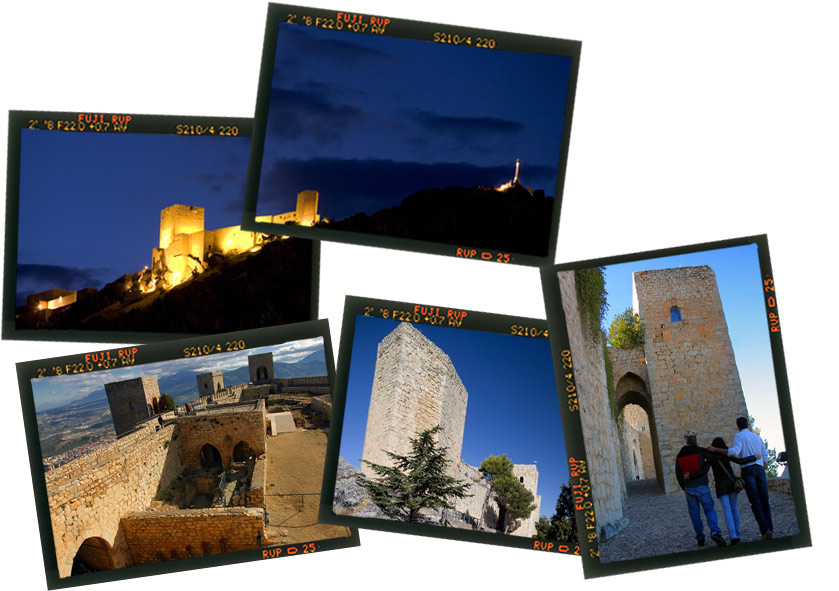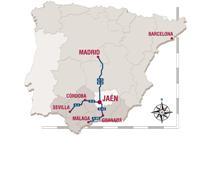Monographics - Jaén's Castle
The Arabs built a huge Alcazaba (fortress) on the top of the hill that dominates the city. The Christians conquered the city in the 13th century and transformed this fortress. From that moment it was comprised of three fortifications which were all clearly differentiated: Abrehuy’s castle, Old Alcázar and New Alcázar. The National Parador (hotel) was built over the fist two fortresses in 1965; the works of the Parador required the destruction of most of the fortified complex. The new Alcázar was preserved and its original structure still remains.
ORIGINS
The first defensive walls of Santa Catalina hills date back to the Iberian period. They are part of the little oppidum of the northern slope that was extended in the Roman Republican period. The rest of the settlement occupied the peak and the northern slope.
ISLAMIC PERIOD
In the Islamic Period Abd al-Rahman II moved the capital of the Cora from La Guardia (Mantisa) to Yayyan (Jaén). This move included an ambitious official work programme, including the construction of a mosque, a fortress on the hills and the installation of a water supply system for Magdalena Spring. Clear evidence of the growing prosperity of the city was that Jaén had five Arab baths; only two of them were discovered. Between the 11th and 12th century, the walled enclosure was extended to be able to lodge the old Emiral-Caliphal city which was rapidly growing. Together with that, a new Aljama mosque was erected due to population growth in the city. it was located in the east end of Jaén where the cathedral is placed today. At the same time the hydraulic systems were also extended and developed, new mosques, baths and palaces were built.
CASTILIAN CONQUEST
During the Christian Conquest of Guadalquivir Valley, Jaén had resisted several attacks until 1246 when the king of Granada, Ibn-Alhamar declared himself vassal of Fernando III; he lost the city and undertook the payment of a tribute. Jaén became a border area of first order and Episcopal headquaters (the headquarters had moved from Baeza). Jaén developed and its walled enclosure was extended to lodge two quarters in the outskirts of the city, San Ildefonso and Las Monjas. In the 14th century the Arab’s troops took the city by surprise, but they were unable to conquer the fortresses, so they had to leave again. The late middle Ages are characterised by a period of intense activity in the borders of the city, also for the fights between the nobility, especially by the constable of Castile Miguel Lucas de Iranzo, loyal to king Henry IV who was against eastern nobility.
THE RESTORATION
In 1907, the castle was acquired by Manuel Ruiz de Córdoba; he did a little restoration to the castle. In 1948, the castle became municipal property undergoing several reforms that culminated in 1965 with the construction of the National Parador, whose construction work destroyed an important part of the old remains.
SAINT CATALINA
Lots of military events were supposed to be related to miracles and religious apparitions in that period. These were very common in the middle Ages, and were due to the religious elements of the struggle. There are also lots of legends about the apparitions in the conquest of Jaén: Saint Catalina of Alexandria appeared in the dreams of Ferdinand III to announce to him that he was going to succeed in the struggle for the city. It was the third time that he has besieged the town and was about to leave because of the strong defences of Jaén. The Arabs erected a huge Alcazaba fortress on the top of the hill that overlooks the city. The Christians conquered the city in the 13th century and transformed this fortress; from that moment it was comprised of the three fortifications which are clearly differentiated: Abrehuy’s castle, Old Alcázar and New Alcázar. The National Parador was built over the fist two fortresses in 1965, the works of the Parador required the destruction of most of the fortified complex. The new Alcázar was preserved and its original structure still remains. The saint told him to resist in the struggle and showed him the keys of the city. The day after, Alhamar went to the Christian camp offering him the keys of the city. Some people mistakenly think that the takeover of the city was on the 25th November, the day of Saint Catalina, but the truth is that it was a day in February. There are two versions of this legend; the alternative is more fantasised is considered to be politically incorrect. The legend reports that the Saint went to the keep tower and called the name of the Arab king; he appeared in the window and lost his head, beheaded by the wheel of knives which represents the symbol of the Saint. In any case, Saint Catalina is the patroness Saint of the city, once a year a feast in her honour is celebrated in Jaén in February on the foothills of the castle.
HISTORY
After the Islamic occupation, a large Alcazaba fortress was built on the top of the northern slope of the hill of SaNTA Catalina which dominates the city of Jaén. This place was organized into two clearly differentiated areas: on one side, a walled enclosure was placed at the top of the hill, whose characteristics and dimensions are unknown to us; on the other side, the Alcazaba itself, located on the slope, built upon the remains of the old Roman wall in order to protect the Madina (old quarter). We can still observe the remains of a rectangular building with an arcaded courtyard which is speculated to be the palace and residence of the first governors of the city during the Emiral and Caliphal period.
Servicios
Centro de Interpretación
"Castillo de Santa Catalina"
Propiedad
Municipal y Paradores de Turismo.
The changing politic situation of Al-Andalus in the 11th and 13th centuries led to the restoration of this walled enclosure. The old Alcazaba was abandoned and immediately become a residential area, and the politic-administrative area was moved to the top of the hill, where a large fortress, with two walled areas at different heights, was built. The Abrehuy castle, the smaller, occupied the lowlands of the hill and leads us to the main precinct, the Old Alcazar that occupied the largest part of that mountaintop. Two cisterns were built inside of the fortress for water supply; in the more strategic area in the east a new palace was built. It was decorated with colourful atauriques (plaster decorations); inside we can find storerooms, cisterns, warehouses and other rooms. After the Christian Conquest in 1246, Ferdinand III planned the construction of a new Alcazar castle in the most strategic area where the Islamic palace was sited. However, it was his successors Alfonso X and Ferdinand VI who built the New Alcazar, a triangular shaped fortress with an area of 3.200 square metres consisting of four towers, two watchtowers and a Homage Tower. In the edification they used stretches of the wall and some towers of the former Old Alcazar that were coated with thick walls of irregular masonry. The castle is accessed by a splayed arch door with a pointed arch, which allows access to the parade ground, it is said that it might be the zone of the castle that has changed the most after the Christian Conquest and especially after the works inside the building at the beginning of the 19th century.
THE TOWERS
Among the five towers of the New Alcazar we can highlight the keep tower due to its dimension and altitude. It is a square based construction 40 metres tall, built with irregular masonry with ashlars in the corners located under a rocky outcrop in the highest point of the mountain. It is organized into three areas. The first, a warehouse carved into the rock, maybe exploiting an old cavity, which can be directly accessed from the parade ground. It has four semicircular vaults on a central pillar. The rooms with vaulted ceilings of the upper floor were used as the residence of the Mayor and his family. The right side of this tower is connected with the Damas Tower through a stretch of the wall whose bailey is still preserved. The Damas Tower is divided into two functional spaces: the lower one is the largest and is covered by wooden lintel roof, the second one (the upper room) is covered by a brick vault, and it was probably used for storage. Next to this tower we can find the Watchtower, also called Saint Catalina Chapel, because it houses a small chapel with a sculpture of the Patron Saint of the city. This chapel is covered by a pointed shaped vault decorated by a frieze of castles and lions. The former tower was a solid crenellated tower, but at the end of the 15th century, during a period of tranquillity in the borderlands, a small chapel was ordered to be built in the terrace by the constable Miguel Lucas of Iranzo due to his sister’s wedding. Further to the East, we can find a second Watchtower, whose original structure still remains. This tower had no battlements, but another similar little chapel was built in a polemic restoration trying to imitate that of Saint Catalina. Next, we can find the Vela Tower which has a pentagonal structure; it was a former Islamic tapial tower that became a warehouse accessed by a trapdoor. We can find two upper rooms, one with lintels and the other is a little room covered with a pointed barrel vault used for storage or garrison sleeping accommodation. The last tower is called Troneras; it houses a vaulted room where the latrines were placed. It had a special ventilation system to avoid odours. Next to this tower there is a small gate. After the conquest of the Nasrid kingdom of Granada and the disappearance of internal borders, the fortification underwent a marked decline until it was finally abandoned in the 18th century. Nevertheless, the Napoleonic Invasion in 1808 made it necessary to refurbish the castle. Most of the indoor room’s remains of the fortress were destroyed and buried under a thick layer of rubble in order to allow a large parade ground to be divided into two clearly differentiated areas: the lower courtyard, close to the main entrance, and the upper courtyard, placed at the old bailey level to get expeditious movement of the artillery within the castle. When the Napoleonic troops took the city, they turned the fortifications of Santa Catalina’s hill into an important stronghold to control Guadalquivir Valley and Sierra Morena. Several buildings were erected to house the troops inside the Old Alcázar and the defences of the castle were reinforced. The New Alcázar was the residence of military authorities. Between the main entrance and the Watchtower a bakery was built. In the lower courtyard, some pavilions were built to lodge the stables, the powder stores and the rooms of some authorities. In the upper courtyard they built a hospital, a prison and the gallows.
HOW TO GET TO THE CASTLE
Access
It can be accessed by the ring road of Jaén, from the Cordoba motorway, from the Magdalena quarter or from the other side of the city via a route from Santa María Square (cathedral and city council), Carrera de Jesús Street, continue across the passage Tiro Nacional until connecting with the aforementioned ring road. There, go up the Neveral and Parador Road.
No Difficulty
Parking
There is a car park near the Parador with capacity for buses.















